
The buff-tip is a moth of the family Notodontidae. It is found throughout Europe and in Asia to eastern Siberia. The species was first described by Carl Linnaeus in his 1758 10th edition of Systema Naturae.

Cerapteryx graminis, the antler moth, is a moth of the family Noctuidae. It is a common species throughout most of Europe but is lacking in the very dry southern regions. The northernmost occurrence is Iceland, and above the Arctic Circle. It also occurs in Siberia and in North Mongolia. The species has been introduced to North America. In the Alps it rises to an altitude of 2100 meters.

The minor shoulder-knot is a moth of the family Noctuidae. The species was first described by Johan Christian Fabricius in 1776. It is distributed throughout Europe then east across the Palearctic to Siberia and Japan. It also occurs in Turkey.

Apamea crenata, known as the clouded-bordered brindle, is a moth in the family Noctuidae. It is distributed throughout the Palearctic realm. In the North it crosses the Arctic Circle, in the Mediterranean it is found only in cool locations and mountains avoiding very hot areas. In the Alps, it rises to an altitude of about 2000 metres.
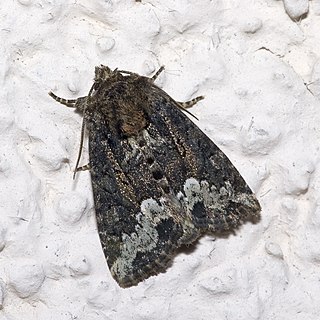
The marbled minor is a moth of the family Noctuidae. The species was first described by Carl Linnaeus in his 1758 10th edition of Systema Naturae. It is distributed throughout Europe, east through the Palearctic to central Asia and the Altai Mountains. It rises to heights of over 1500 meters in the Alps.
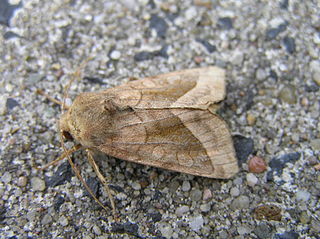
Hydraecia micacea, the rosy rustic, is a moth of the family Noctuoidea. It is found across the Palearctic realm from Ireland to Siberia. It reaches Japan and is introduced to eastern USA, Quebec and Ottawa.
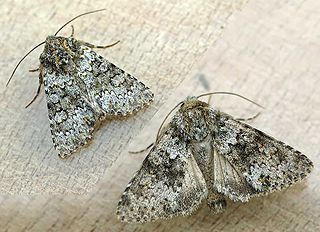
Hecatera dysodea, the small ranunculus, is a moth of the family Noctuidae. It is found in Europe, primarily in Central Europe and Southern Europe The northern boundary of the distribution is from the Baltic Sea and the southern part of Lithuania, Belarus, south of Moscow to the Urals. North Africa forms the distribution border in the south east they extend to the Middle East, Turkestan and across the Palearctic to Central Asia. It is an introduced species in North America, where it was first found in Utah in 1998 and Oregon in 2005.

Dysgonia algira, the passenger, is a moth of the family Noctuidae. The species was first described by Carl Linnaeus in 1767 and is found in the Palearctic - from the southern half of Europe and parts of North Africa through West, Central and South Asia.

Protodeltote pygarga, the marbled white spot, is a species of moth of the family Noctuidae. It is found in the Palearctic realm.
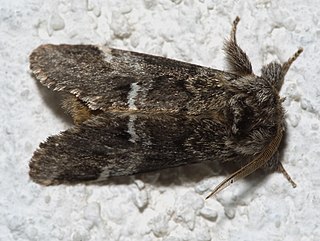
Drymonia dodonaea, the marbled brown, is a moth of the family Notodontidae. The species was first described by Michael Denis and Ignaz Schiffermüller in 1775. It is found in Europe and in the area surrounding the Caucasus.

Notodonta ziczac, the pebble prominent, is a moth of the family Notodontidae. It is found in Europe ranging to Central Asia.

Catocala sponsa, the dark crimson underwing, is a species of moth of the family Erebidae. It is found in Europe, North Africa and from Anatolia up to the Caucasus.

Mythimna straminea, the southern wainscot, is a moth of the family Noctuidae. The species was first described by Georg Friedrich Treitschke in 1825. It is found in the western parts of the Palearctic realm, including Morocco, Europe, Turkey, the Caucasus, Israel, and Lebanon.
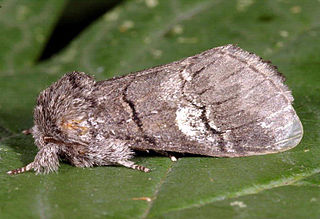
Drymonia querna, the oak marbled brown, is a moth of the family Notodontidae. It is found in the Middle East and mainland Europe except the north.

Odontosia carmelita, the scarce prominent, is a moth of the family Notodontidae. The species was first described by Eugenius Johann Christoph Esper in 1798. It is found in central Europe, ranging to Ireland and Finland in the north and Russia in the east.

Lygephila craccae, the scarce blackneck, is a moth of the family Erebidae. It is found in temperate Europe and across the Palearctic to the Altai Mountains, Korea, Japan and China.
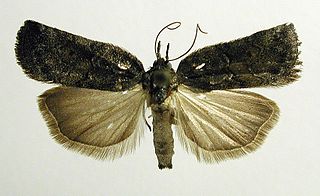
Nycteola revayana, the oak nycteoline, is a moth of the family Nolidae. The species was first described by Giovanni Antonio Scopoli in 1772. It is found from Europe and east across the Palearctic to Japan and India.
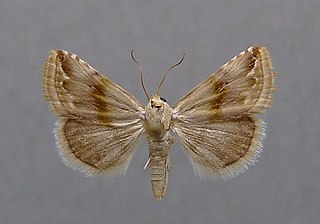
Eublemma ostrina, the purple marbled, is a moth of the family Erebidae. The species was first described by Jacob Hübner in 1808. It is mainly found in central and southern Europe, and further east, but is also a scarce migrant in the United Kingdom, where it is mainly found along the south coast.
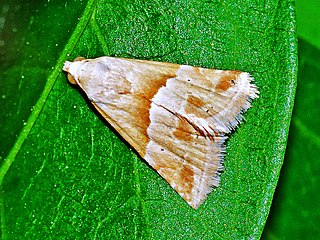
Eublemma parva, the small marbled, is a moth of the family Erebidae. The species was first described by Jacob Hübner in 1808.

Elaphria venustula is a moth of the family Noctuidae. It is found in most of Europe, except the north. In the east, the range extends through the Palearctic to the Pacific Ocean.





















